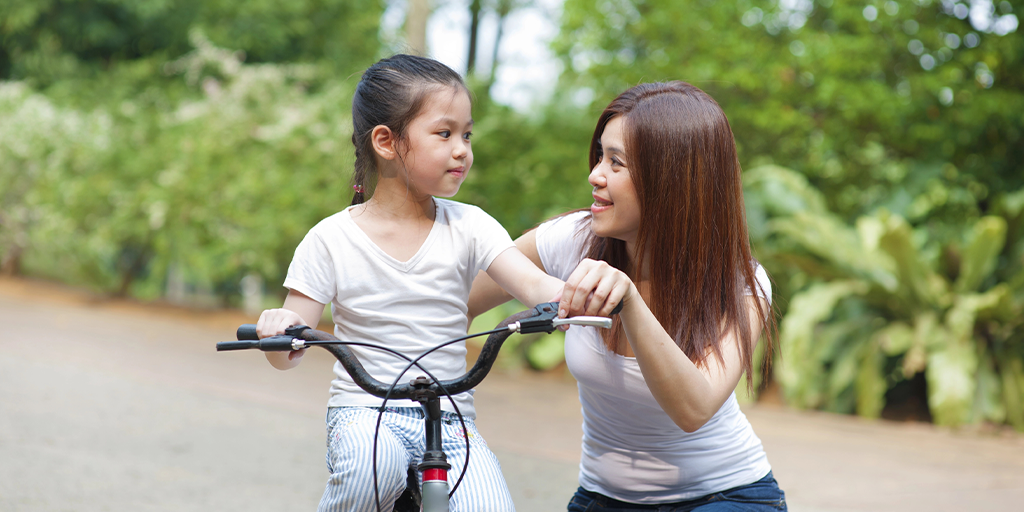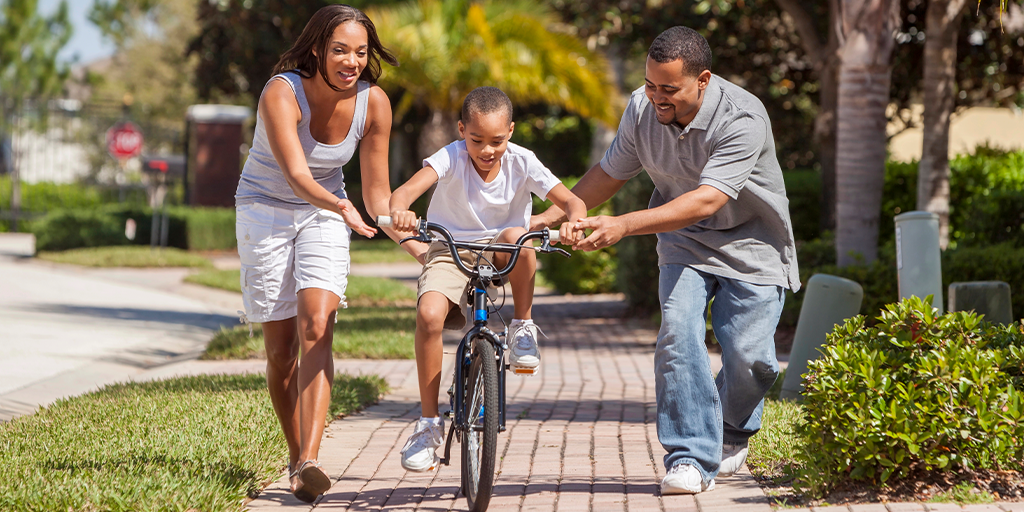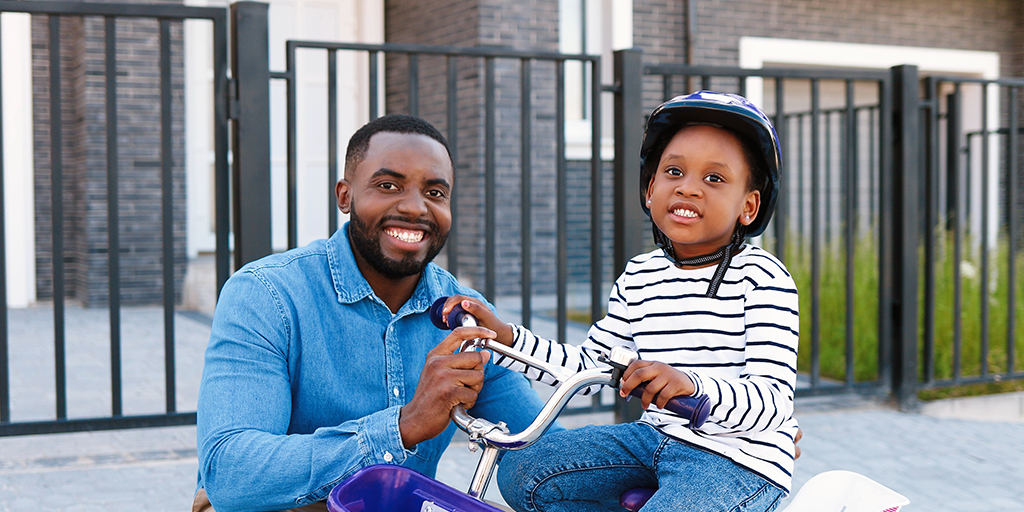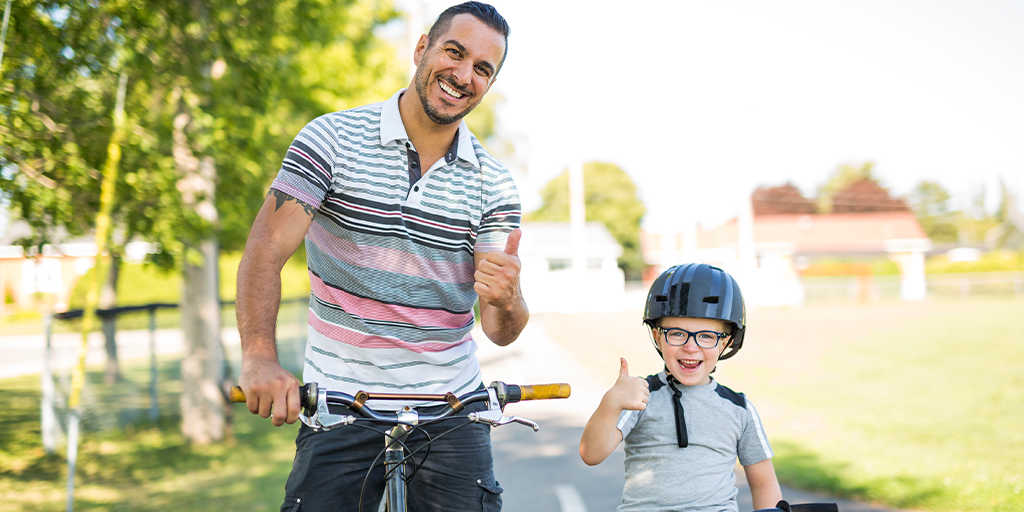As a parent, few things are more exciting than watching your child learn and grow. Riding a bike is a rite of passage for many kids and a skill that will stick with them for a lifetime. But teaching your child to ride a bike can also be daunting. You want to ensure they’re safe, and instill confidence and a sense of independence. In this article, we’ll provide some tips and tricks to help make the process as fun, smooth, and stress-free as possible. It may even save your kiddo a few skinned knees.
When’s the Best Age to Teach Your Kid to Ride a Bike?
Most children are ready to start learning to ride a bike between the ages of 3 and 6. But it can depend on several factors, including physical coordination and, most importantly, interest and enthusiasm.
A balance bike can be a great starting point for younger children, especially toddlers from as early as 18 months to 2 years old. Balance bikes do not have pedals and allow children to learn steering and balancing by pushing along with their feet. This early introduction can make the transition to a pedal bike smoother and often eliminates the need for training wheels.
By age 4 to 5, many children who have started on balance bikes are ready to move on to pedal bikes. At this stage, they typically have developed a good sense of balance and can handle a pedal bike more easily. For children starting directly on pedal bikes, with or without training wheels, the age range of 5 to 6 years old is a typical time to start.
In conclusion, there isn’t a universal “best age” to learn how to ride a bike. It’s more about gauging your child’s physical abilities, interest, and readiness. Starting with a balance bike can offer an easier transition, but the most important thing is to make the process fun and encouraging.
Gear Up: Bike Riding Prep
Finding the perfect bike for your child isn’t just about picking their favorite color or cool accessories (for the record—team streamers). You need a bike that fits just right and matches your kiddo’s age and stage. Here’s what to consider:
- Size Matters: The right bike size is essential for your child’s comfort, safety, and success. When seated, your kiddo should be able to place both feet flat on the ground. Check the reach (the distance between the seat and handlebars). Your child should be able to reach the handlebars without leaning too far forward. While it’s tempting to buy a bike that is too large for your kiddo to grow into, don’t—it will be too difficult for them to handle and control. For toddlers and younger children, a balance bike can be a great start at building towards the complex skills bike riding requires.
- Balance Bikes vs. Training Wheels:
- Balance bikes are designed to foster a child’s confidence and grasp of balance from a very young age, sometimes as early as 18 months. By allowing children to scoot along using their feet to propel themselves forward, balance bikes help them develop essential coordination skills, making the eventual transition to pedal bikes smoother.
- On the other hand, traditional bicycles equipped with training wheels remain a popular choice for parents. While they may not emphasize balance as much as balance bikes, they excel at teaching children how to pedal early in their biking journey. Training wheels provide stability, giving children the confidence to focus on mastering the mechanics of pedaling without the fear of falling over.
Don’t forget the safety gear!
Every child should wear a helmet when riding a bike (or a trike or scooter). Helmets should be snug but comfortable, sitting low on the forehead and no more than a couple of fingers’ width above the eyebrows. Knee and elbow pads can protect your kiddo from scrapes and bruises, especially as they’re getting started.
Where Should You Practice Bike Riding?
Your kiddo’s comfort and confidence play a huge role in bike riding success. Don’t push them beyond their comfort zone, and practice riding in quiet, safe, and familiar spots. Areas free from heavy traffic and distractions that can overwhelm your little rider are ideal. Quiet parks, empty parking lots on weekends, or neighborhood cul-de-sacs are excellent choices.
Choose a flat-paved surface—it allows for smooth rolling without the added challenge of hills or bumps. Grass may seem like the better option, but it actually makes pedaling and balancing tricky for beginners. Make sure there’s enough room for your child to maneuver without obstacles, and practice panic-free steering and braking.

How to Get Started
Teaching your kid to ride a bike involves emotional preparation, too! In addition to learning new physical skills, your kid is also building confidence, managing emotions, and working on his or her “frustration tolerance.” Start each lesson with simple, achievable goals to give your child a sense of accomplishment. For example, you might teach your child to sit on the bike and walk it forward. Celebrate these small victories enthusiastically and make them feel like a superhero.
It’s natural for children to feel apprehensive about falling or failing. Reassure them that it’s okay to be nervous and that every mishap is part of the process. Show them how to fall safely (e.g., stepping off onto the ground) and explain that helmets keep noggins safe.
And don’t forget to check yourself: Your attitude majorly influences your child’s experience. Remain patient and calm, even when progress seems slow. Avoid showing frustration or disappointment over setbacks. Instead, use encouraging words and let your child know it’s okay to take breaks and try again later. When all else fails, a little silliness always helps reset attitudes.
Bike Riding Teaching Techniques
The fastest, most effective way to teach your kiddo to ride a bike? Focus on balance—the most challenging skill—and pedaling second. How? Start with a balance bike, or modify a regular bike by removing the pedals, and allow your child to concentrate on learning to balance, glide, and steer. If your bike has training wheels, remove those, too.
Have your child sit on the bike and adjust the saddle so that their feet are flat on the ground and their legs very slightly bent (this may mean the seat is at its lowest possible height). With their weight fully on the seat (as opposed to their legs), encourage your kiddo to use their feet to walk the bike forward. A gentle reminder: They should be wearing a helmet, even for snail’s pace riding.
Once comfortable walking their bike, graduate to running and coasting. Teach them to lift their feet off the ground for short periods to experience the feeling of balancing on two wheels. If they’re having trouble picking up speed, give them a boost or let them roll down a driveway. During your coasting practice sessions, remind them to sit straight and look forward (as opposed to their feet).
When they’ve mastered balancing and gliding, you can begin work on steering and turning. Start with easy, oversized loops and figure eights, or try a few frustration-free games:
- Obstacle Course: Set up a simple obstacle course with cones (or whatever you have handy!) and have your kiddo steer around them.
- Biking for Two: Dust off your wheels, strap on a helmet, and let your child follow you on your bike. Take it slow and easy, with wide turns and no sudden stops.
- Controlled Stopping: Teach your child to use their feet to stop the bike gently and incorporate it into your games. It improves balance and prepares them for using brakes during future rides.
How to Teach Riding a Bike with Pedals
How will you know when your child is ready to learn to ride a bike with pedals? Here’s your checklist:
- They can coast with their feet up.
- They can make turns while coasting.
- They can look straight ahead while riding.
If your kiddo has mastered these three skills, they’re ready for genuine cycle time. Next, reintroduce the pedals. Have them sit on the bike while you straddle the front wheel and face them while holding the handlebars. Let your child practice picking up their feet and finding the pedals while looking straight ahead (looking down makes it more likely they swerve the handlebar).
Before your child starts burning rubber, let them experiment with operating the brakes to get a feel for the pressure they need to apply. For coaster (rear) brakes, hold onto the bike while coasting and have them apply the brakes gently until they can slow down and stop without too much wobbling. If the bike has handbrakes, have your child walk alongside it, hands on the handlebar grips, and a few fingers on the brakes. Let them practice slowing the bike while they walk.

Get Going!
For beginning bikers, it’s easiest to use the pedals once they’ve already got momentum. Have them jog into a glide without the pedals, and once they’re fast enough, tell them to put their feet on the pedals and go!
To start from a stopped position, show them how to place one foot on a pedal raised in the 2 o’clock position and push down to start moving. Make it clear they need to push down hard to get going! Encourage them to put the other foot on the pedal as they move forward to keep momentum.
Avoid holding onto your child’s bike as they begin to pedal. They need to learn how to balance independently and gain confidence in riding solo. If your child struggles initially, you can support the bike briefly to help them get the hang of it. But if you find yourself needing to hold the bike almost continuously, they may need to spend more time developing their balancing skills before moving on to this stage.

Practice Makes Perfect
Consistent practice is key to helping your child master bike riding, but it’s also essential to strike the right balance between practice and time off. To maintain enthusiasm and avoid fatigue, schedule regular short practice sessions. For young children, 15 to 30 minutes of “training” several times a week is ideal. This frequency keeps the activity fun and manageable without overwhelming them. Remember, the goal is to build positive associations with bike riding, so keep the sessions light and end on a high note whenever possible.
As your kiddo becomes more comfortable and confident on their bike, you can start introducing more complex skills:
- Riding on Different Surfaces: Begin on smooth, flat surfaces and gradually introduce new types of terrain. For instance, let them try riding on grass or dirt paths, which require more effort to pedal and maintain balance. Variety keeps the practice exciting but also improves their handling skills.
- Navigating Slight Inclines: Start with very gentle slopes. Teach your child to lean forward slightly to go uphill, and to coast and use the brakes when going downhill. These practices help them understand how to control the bike under different conditions and build their confidence.
Basic Bike Maintenance Tips
Bike riding can be a parenting moment of zen: A perfect opportunity to inject a little personal responsibility into something fun. Before each practice session, check that the tires are properly inflated, the brakes work well, and the chain is intact and clean. This routine teaches your child the importance of taking care of their belongings and ensures the bike is safe to ride—double bonus! Show your kiddo how to wipe down their bike after a ride, especially if they’ve ridden through mud or on dusty paths. It can prevent rust and prolong the life of the bike.
Tips for Adjusting the Bike as Your Child Grows
As your little one grows and blossoms, so too should their bike! Here’s how to make simple adjustments to keep their ride comfortable, safe, and just right for their ever-changing needs.
- Seat Height: The seat should be adjusted so that when your child sits on the saddle, their feet can touch the ground with a slight bend in the knees. This position provides stability and confidence as they learn.
- Handlebar Height: Adjust the handlebars for comfort and control. They should allow your child to hold them without hunching over or stretching too far forward.
- Skill Improvements: As your child becomes more skilled, adjustments may be necessary for better performance, such as raising the seat height to allow for more efficient pedaling once they are confident enough not to touch the ground frequently.
Finding What’s Right for You
Albee Baby is the oldest family-owned specialty baby shop in the US. We pride ourselves on providing our customers with the best assortment of baby products anywhere, at fair prices, always. We’re committed to being an inclusive resource for parents and hope you feel empowered to find the right baby gear for your family. Still have questions? Feel free to contact our baby gear experts at 877.692.5233 or [email protected].

